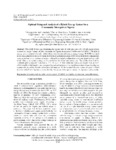| dc.description.abstract | This study focuses on determining the optimal size of each component of a hybrid energy system to meet the energy demand of Itele community in Nigeria at minimum Net Present Cost (NPC). The hybrid energy system consists of a solar photovoltaic, wind turbine and battery energy storage. HOMER was used as the optimization tool. In this research, the feasibility and optimal sizing of two different hybrid configurations were carried out. A standalone and an unreliable grid connected configuration was investigated and optimally sized. Also, a comparative study on the environmental effect was carried out. The results show that the unreliable grid connected mode had a NPC of $22.7 million while the standalone system had an NPC of $29.9 million. But based on environmental impact and emissions, the standalone system offered the cleanest system with zero carbon dioxide and sulfur oxide emission. While the unreliable grid connected system offered emission with 394.934 kg/year of carbon dioxide, 742 kg/year of nitrogen oxide and 1517 kg/year of sulfur oxides. | en_US |

